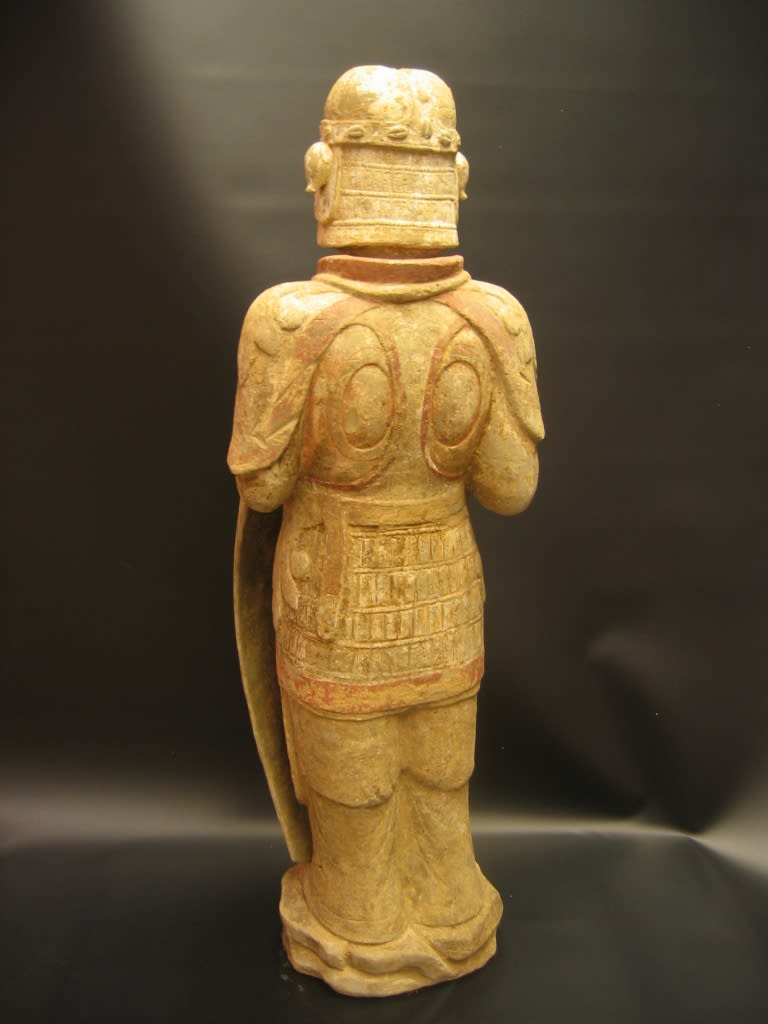Eastern Wei Painted Pottery Warrior Carrying a Shield, 534 CE - 550 CE
Terracotta
height 77 cm
height 30 1/4 in
height 30 1/4 in
DL.2076
Further images
This spectacular terracotta figure of a standing warrior belongs to a class of objects known as ‘mingqi,’ literally ‘spirit goods.’ These were items buried with the dead to ensure that...
This spectacular terracotta figure of a standing warrior belongs to a class of objects known as ‘mingqi,’ literally ‘spirit goods.’ These were items buried with the dead to ensure that all their social and material needs would be met in the afterlife. Originally mingqi were fashioned from expensive materials such as bronze or jade but from the third century BC burial sculptures of fired ceramic became more common. This was a trend that lasted until the demise of the Tang Dynasty when burial customs changed and offerings were burnt in the belief that the smoke would carry the essence of the goods to the next world. The production of ceramic grave goods created new opportunities for sculptors to produce increasingly naturalistic and detailed works of art.
This heavily armoured warrior was produced to guard the deceased for eternity. Standing on a plinth, he wears pointed boots and a helmet with protective neck and ear flaps. A shield, embellished with an animal mask and dancing creatures, is supported in his left hand. His right is positioned to hold a lance or spear that would have been fashioned from a perishable material such as wood. The facial features are striking, especially the thick eyebrows and upturned moustache. Modeled in the round, the detail of the armour is equally impressive on both sides.
Considerable traces of the original red pigment survive. Decorated with a technique known as ‘cold painting’, the warrior would have been embellished with mineral pigments after firing. These were applied over a white ground which is now partly visible. In contrast to glazing, this technique produced a more delicate and naturalistic effect and the range of colours available was more varied. The head of the warrior was made separately and is removable. Although never intended to be viewed by the living, this piece is a supreme example of the potter’s skill during the Eastern Wei period. (AM)
For a comparable example see, V. L. Bower, ‘From Court to Caravan: Chinese Tomb Sculptures from the Collection of Anthony M. Solomon,’ (New Haven and London, 2002), p. 93, no. 20.
This heavily armoured warrior was produced to guard the deceased for eternity. Standing on a plinth, he wears pointed boots and a helmet with protective neck and ear flaps. A shield, embellished with an animal mask and dancing creatures, is supported in his left hand. His right is positioned to hold a lance or spear that would have been fashioned from a perishable material such as wood. The facial features are striking, especially the thick eyebrows and upturned moustache. Modeled in the round, the detail of the armour is equally impressive on both sides.
Considerable traces of the original red pigment survive. Decorated with a technique known as ‘cold painting’, the warrior would have been embellished with mineral pigments after firing. These were applied over a white ground which is now partly visible. In contrast to glazing, this technique produced a more delicate and naturalistic effect and the range of colours available was more varied. The head of the warrior was made separately and is removable. Although never intended to be viewed by the living, this piece is a supreme example of the potter’s skill during the Eastern Wei period. (AM)
For a comparable example see, V. L. Bower, ‘From Court to Caravan: Chinese Tomb Sculptures from the Collection of Anthony M. Solomon,’ (New Haven and London, 2002), p. 93, no. 20.







